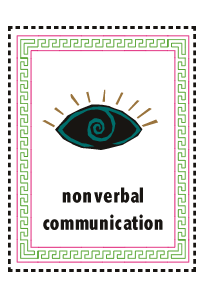NVC Impairments
Teachers
can help children by becoming aware of the kinds of disabilities
related to NVC, and by being proactive and modeling the specific
behaviors of defined social skills. This type of modeling can be done
in the classroom during a class meeting or open focus groups
specifically dedicated to problem solving. As you have seen in the
previous pages, modeling can be done with the use of Role Plays,
Simulations and/or Games.
You can learn more information about various types of Nonverbal Learning Disabilities from the articles, books and websites provided below.
Promoting Social Skills Among Students With Nonverbal Learning Disabilities
from Teaching Exceptional Children, JAN/FEB 2002
Author: Stephanie Morris
Vol. 34, No. 3, pp. 66-70. Copyright 2002 CEC.
Link to Article: http://www.dldcec.org/pdf/Article9.pdf

Inability to read emotions may be due to mild Autism - Asperger's Syndrome:
There is an informative article describing Asperger's Syndrome on Wikipedia. See details at the link below:
http://en.wikipedia.org/wiki/Asperger_syndrome
Nonverbal social skills disorders are associated with ADHD and ADD:
Please check out the article on ADHD (ADD) respectively at the link below:
http://en.wikipedia.org/wiki/Adhd
Research indicates that education and training make a difference when addressing these kinds of problems.
Learn More about Dyssemia
Dyssemia is a term coined by psychologists Marshall Duke and Stephen Nowicki in their 1992 book, Helping The Child Who Doesn't Fit In, to decipher the hidden dimensions of social rejection, and describe difficulties with receptive and/or expressive nonverbal communication. The term comes from the Greek dys (difficulty) and semia (signal). Dyssemia is defined as "difficulty in using nonverbal signs or signals."
Dyssemic Children:
- Have difficulty sending and reading nonverbal cues of emotion, space and liking/disliking.
- Don't understand how to engage in social interaction.
- Are often seen as "weird" or "off-putting" by other kids (and even teachers and adults).
Dyssemia - How Common Is it?
- About 10% of children and adults have Dyssemia
- About 7-10% of children and adults are eusemic (have extraordinary ability to read and use nonverbal social skills)
- The vast majority (80%) of children and adults fall somewhere in between
Most children will benefit from learning effective Nonverbal Communication, and it is particularly true for Dyssemic children.
A psychological test is available to help in the diagnosis and assessment of people with the condition of Dyssemia. The test is known as the Diagnostic Analysis of Nonverbal Accuracy (DANVA). The test helps to determine a child’s ability to identify facial expressions. In the next section you can read more about the test. There is also a link to the test so you can try it for yourself.Licensed under the Creative Commons Attribution-NonCommercial-ShareAlike 2.5 License
Brought to you by CReducation.org.